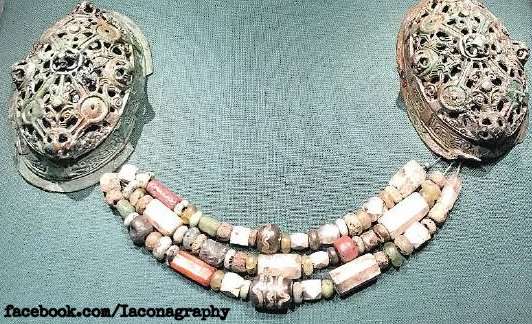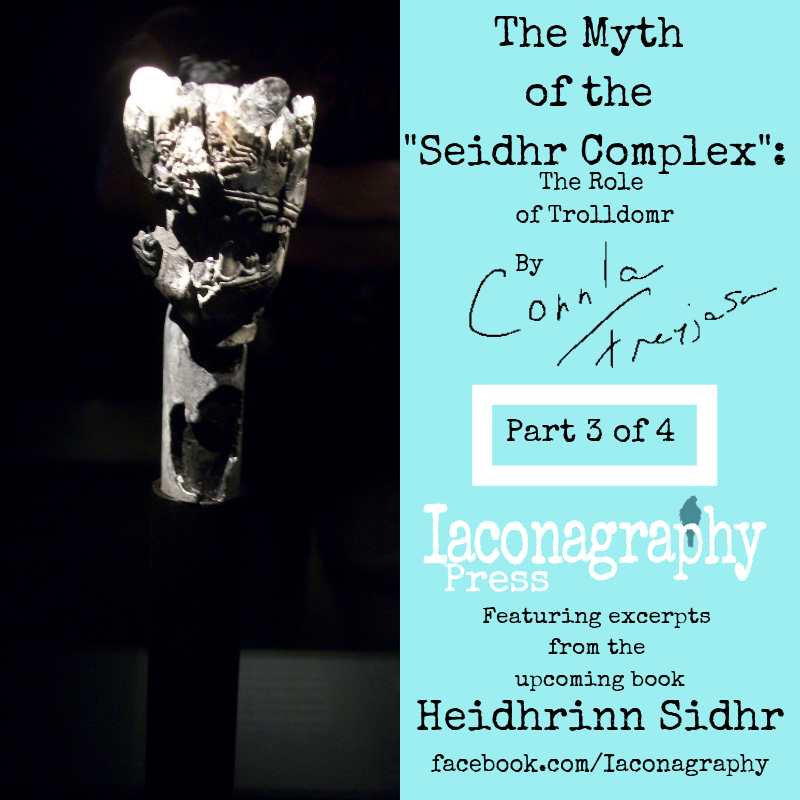The Myth of the “Seidhr Complex”: Part 1 of 4

Aren’t the Path of the Vitki/Volva, the practice of Trolldomr, and the Path of the Seidhr-Bearer all part of the “seidhr complex”? Traditionally, yes, many practitioners and most scholars have classified them as such, and, in truth, one may find themselves walking more than one of these paths at any given time in their practice, perhaps even at the same time. By the same token, you may find that as a Norse Witch/practitioner of Heidhrinn Sidhr, your particular brand of authenticity places your feet on only one of these three paths, that of the vitki/volva, and there’s nothing wrong with that, either. What is important is to have a basic understanding that the three are decidedly not the same, historically nor in active practice.
The primary argument for all three of these paths being different aspects of the “seidhr complex” has traditionally been based in the fact that they are all shamanic in nature. But the entire faith-base of Iron Age Scandinavia was shamanic, so that is hardly a valid reason for clumping together such varied practices into one “heading” or “complex”. Scholars have not assisted very much in this common misunderstanding, largely because none of them are working from a truly ethnographic base. What do I mean by that? I mean that none of the archaeologists currently working on this field of study—and some of them are archaeologists who are my personal heroes, so don’t get it twisted—have any experience with actual practice, or even attempted practice, of any of these “branches” of “Norse magick”. They’re basically working from a place of theory only. Look at it this way:
Imagine, fifteen hundred years from now, that a group of archaeologists discover a site in Salem, Massachusetts that was formerly a Pagan shop. Hopefully you can at least marginally imagine the sort of shop I mean. Let’s say they excavate an approximately twenty-four foot by thirty-six foot space. Near the front of the space, they find what was apparently an altar table, well-preserved, thanks to the dampness of the climate. On it is a cauldron and candle holders, remnants of what appear to be monetary offerings; the chitinous remains of a shell, showing evidence of burnt offerings of some kind as well. To the immediate left of this, they find a host of daggers of varying shapes, sizes, materials, and iconography. Further left, they find shards of glass; evidence of bottles which apparently contained liquid, seashells, and varying herbs of some sort. Throughout the site, they discover statues: Baphomet, Freyja, Freyr, Tyr, Brighid, Cerridwen, Bastet, Sekhmet, Anubis, Thoth.
Because you and I live in the century during which this shop was actually in business, we understand that all of these artifacts are representations of various tools of widely varied paths of practice: Modern Traditional Witchcraft, Wicca, the Feri Faith, Kemetic Orthodoxy, Druidry, and Norse Traditional. But to those archaeologists, fifteen hundred years from now, it will be very easy to draw the wrong conclusion: that all of these items represent some form of twenty-first century “witchcraft complex”. Basically, that is precisely what has happened within the modern understanding of the “seidhr complex”.
I have myself been a practicing vitki for the past two years, and a godhi now for almost a year. As such, this has presented me with an opportunity to develop a rich ethnography of modern American Heathen practice, accumulated mostly via participation in online groups at Facebook. Supposedly, American Heathenry is a historical-reconstructionist faith, which is to say that modern practice is supposed to be based, or at the very least sourced, from ancient practice. However, a few moments on any of a number of American Heathen Facebook Pages and/or groups and one quickly realizes that most “historical understanding” is based on research dating from the 19th and early 20th centuries, and the majority view is of a “homogenized Heathenry” which patently did not historically exist. The Eddas and Sagas are treated as some sort of “Norse Bible”, a “primary source” that is an absolute and even direct transliteration of the preceding oral culture, and current archaeology is either dismissed or ignored, except on those rare occasions when it holds some sort of novelty (“oh look, that’s a cool sword!”). Those who mention the term shamanism are often maligned as too “New Age-y”, or referred to as “Wiccatru” in a most demeaning manner, even when the archaeological record conclusively proves that the people of the Vendel Period and after fostered a shamanic worldview which cognates neatly with surrounding circumpolar shamanic traditions. Internet “firestorms” seem to be a matter of course in most groups and on most pages: the one thing that all modern American Heathens seem to agree upon is that they enjoy eternal arguments based on utter misinformation almost more than a good quality mead.
One of the major “firestorm” areas in modern American Heathenry is the discussion of the “seidhr complex”. Most people, embarking on such a discussion, immediately begin to use the Lore as a primary source to prove their point, and especially Lokasenna 24. Usually, this quickly turns into not only a belittling and maligning of “magick” as a remote possibility in “true Heathen practice”, but also of the members of the LGBTQ+ community, as these detractors wag their accusatory fingers at those who would deign to cast themselves as ergi or argr, via the practice of “seidhr complex things”. Yet the material culture of the “Viking Age” paints a completely different picture, regarding the acceptance of “gender-blurring”: in a 10th century cremation grave at Valsgarde in Uppland Sweden, a variety of female grave-goods, suggestive of a practicing volva (a female ritual specialist), was discovered, including a very large pair of oval brooches. Upon osteological analysis of the bone material, however, the decedent was determined to be conclusively a middle-aged male. Unlike possibly as much as well over half of the population of Iron Age Scandinavia, this cross-gendered ritual professional received a burial, and not only a burial, but a burial with honor. Clearly, notions of ergi and argr are products of the later Christian period, and Church-influence. Clearly, the Lore is no better than a secondary source.

Even as a secondary source, however, the written lore provides for us a plethora of terms for magickal practitioners within the Norse Tradition, similar to those found in other circumpolar shamanic traditions, such as those of the Saami. Even though sourced from the 13th and 14th centuries, this wide variety of terms provides us with a notion that seidhr was hardly a “catch-all” term to the medieval or even the Iron Age Scandinavians. Of particular interest is the fact that these lists of terms include not only female designations, but also male ones, and that not all of the male ones are negative, as would be suggested by the supporters of the modern “seidhr-is-ergi; ergi is bad” movement. Clearly, even among female practitioners, seidhr was not “the only show in town”; there were as many varieties of magickal practice for women as there were for men, all of which, certainly, contained shamanic aspects, but not all of which were the same as seidhr. But what did any of these practitioners actually do? We will explore the answer to this question, via an exploration of cognitive archaeology, over the course of the next three blog posts. I hope you will join me as we dig up the past in order to better define the present and create a brighter, more magickal future!

(Portions of this post appear in Heidhrinn Sidhr by Connla Freyjason, coming soon from Iaconagraphy Press.)
Bibliography
Cline, Eric. H. Three Stones Make A Wall: The Story of Archaeology. Princeton University Press, 2017.
Graslund, Anne-Sofie. “Some Powerful Women at Valsgarde.” Valsgarde Studies: The Place and Its People, Past and Present, Svante Norr (ed.), Department of Archaeology and Ancient History, Uppsala University, 2008, pp. 65-82.
Hultgard, Anders. “The Religion of the Vikings.” The Viking World, Stefan Brink & Neil Price (eds.), Routledge, 2008, pp. 212-218.
Price, Neil S. The Viking Way: Religion and War in Late Iron Age Scandinavia. Oxbow, 2002.
Price, Neil. “The Archaeology of Seidhr: Circumpolar Traditions in Viking Pre-Christian Religion.” Vinland Revisited: The Norse World at the Turn of the First Millennium, HSANL, St. John’s, 2004, pp. 277-294.
Price, Neil. “Dying and the Dead: Viking Age Mortuary Behavior.” The Viking World, Stefan Brink & Neil Price (eds.), Routledge, 2008, pp. 257-273.
Price, Neil, speaker. “The Viking Mind: The Children of Ash: Cosmology and the Viking Universe”, November 5, 2012, CornellCast.


Hi there Connla,
I am a, so they call it “Young Vitki”, and I have read most of you work and wanted to reach out to see if I could ask a few questions and possibly get some insight into the path.
Thank you in advance,
Einarr Helvig
The “Path” is presently moving in some exciting new directions! For more up-to-date info on those, you might make your way to http://www.heidhrcraft.com (There will be brand new updates and info there soon!) In the meanwhile, stay “young”–ever-seeking; ever-questioning; accepting nothing at face value based purely on the “Lore”–and Shine on!